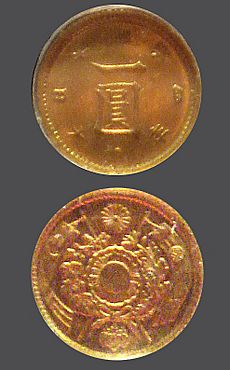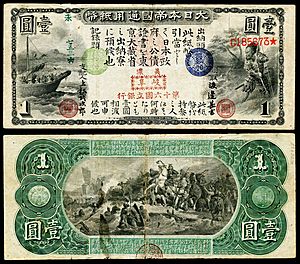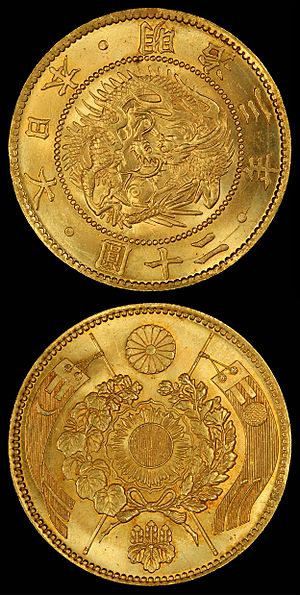Yen facts for kids
Quick facts for kids Yen |
|||||
|---|---|---|---|---|---|
|
|||||
| ISO 4217 Code | JPY | ||||
| User(s) | |||||
| Inflation | 2.6% (July 2022) | ||||
| Source | Statistics Bureau of Japan | ||||
| Symbol | ¥ | ||||
| Plural | The language(s) of this currency does not have a morphological plural distinction. | ||||
| Coins | |||||
| Freq. used | ¥1, ¥5, ¥10, ¥50, ¥100, ¥500 | ||||
| Banknotes | |||||
| Freq. used | ¥1,000, ¥5,000, ¥10,000 | ||||
| Rarely used | ¥1, ¥2, ¥5, ¥10, ¥20, ¥50, ¥100, ¥500, ¥2,000 (no longer in production; still legal tender) | ||||
| Printer | National Printing Bureau | ||||
The yen (Japanese: 円, symbol: ¥; code: JPY) is the official currency of Japan. It is the third-most traded currency in the foreign exchange market, after the United States dollar (US$) and the euro. It is also widely used as a third reserve currency after the US dollar and the euro.
The New Currency Act of 1871 introduced Japan's modern currency system, with the yen defined as 1.5 g (0.048 troy ounces) of gold, or 24.26 g (0.780 troy ounces) of silver, and divided decimally into 100 sen or 1,000 rin. The yen replaced the previous Tokugawa coinage as well as the various hansatsu paper currencies issued by feudal han (fiefs). The Bank of Japan was founded in 1882 and given a monopoly on controlling the money supply.
Following World War II, the yen lost much of its prewar value. To stabilize the Japanese economy, the exchange rate of the yen was fixed at ¥360 per US$ as part of the Bretton Woods system. When that system was abandoned in 1971, the yen became undervalued and was allowed to float. The yen had appreciated to a peak of ¥271 per US$ in 1973, then underwent periods of depreciation and appreciation due to the 1973 oil crisis, arriving at a value of ¥227 per US$ by 1980.
Since 1973, the Japanese government has maintained a policy of currency intervention, so the yen is under a "dirty float" regime. The Japanese government focused on a competitive export market, and tried to ensure a low exchange rate for the yen through a trade surplus. The Plaza Accord of 1985 temporarily changed this situation; the exchange rate fell from its average of ¥239 per dollar in 1985 to ¥128 in 1988 and led to a peak rate of ¥80 against the US$ in 1995, effectively increasing the value of Japan’s GDP in dollar terms to almost that of the United States. Since that time, however, the world price of the yen has greatly decreased. The Bank of Japan maintains a policy of zero to near-zero interest rates and the Japanese government has previously had a strict anti-inflation policy.
Contents
Pronunciation and etymology
Yen derives from the Japanese word 圓 (えん, en, "round"), which borrows its phonetic reading from Chinese yuan, similar to North Korean won and South Korean won. Originally, the Chinese had traded silver in mass called sycees, and when Spanish and Mexican silver coins arrived from the Philippines, the Chinese called them "silver rounds" (Chinese: 銀圓; pinyin: yínyuán) for their circular shapes. The coins and the name also appeared in Japan. While the Chinese eventually replaced simplified Chinese: 圆; traditional Chinese: 圓 with Chinese: 元, the Japanese continued to use the same word, which was given the shinjitai form 円 in reforms at the end of World War II.
The spelling and pronunciation "yen" is standard in English because when Japan was first encountered by Europeans around the 16th century, Japanese (え) and (ゑ) both had been pronounced and Portuguese missionaries had spelled them "ye". By the middle of the 18th century and came to be pronounced as in modern Japanese, although some regions retain the pronunciation. Walter Henry Medhurst, who had neither been to Japan nor met any Japanese people, having consulted mainly a Japanese-Dutch dictionary, spelled some "e"s as "ye" in his An English and Japanese, and Japanese and English Vocabulary (1830). In the early Meiji era, James Curtis Hepburn, following Medhurst, spelled all "e"s as "ye" in his A Japanese and English dictionary (1867); in Japanese, e and i are slightly palatalized, somewhat as in Russian. That was the first full-scale Japanese-English/English-Japanese dictionary, which had a strong influence on Westerners in Japan and probably prompted the spelling "yen". Hepburn revised most "ye"s to "e" in the 3rd edition (1886) to mirror the contemporary pronunciation, except "yen". This was probably already fixed and has remained so ever since.
History
Introduction
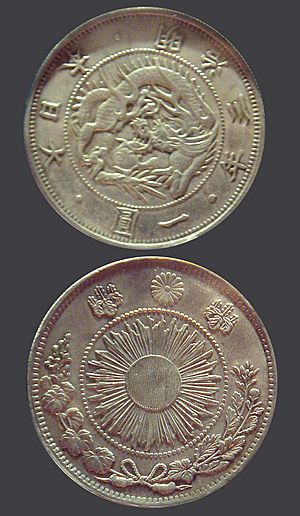
Ōkuma Shigenobu was in charge of Japan's fiscal and foreign policy in the early Meiji period, and he worked with Inoue Kaoru, Itō Hirobumi, and Shibusawa Eiichito run the Ministry of Finance, seeking to introduce a modern monetary system into Japan. Ōkuma proposed that coins, which were previously square, be made into circles, and that the names of the traditional currencies, ryō (両), bu (分) and shu (朱), be unified into yen (円), which was accepted by the government.
On June 27, 1871, the Meiji government officially adopted the "yen" as Japan's modern unit of currency under the New Currency Act of 1871. While initially defined at par with the Spanish and Mexican dollars then circulating in the 19th century at 0.78 troy ounce (24.26 g) of fine silver, the yen was also defined as 1.5 grams of fine gold, considering recommendations to put the currency on the bimetallic standard. The Act also stipulated the adoption of the decimal accounting system of yen (1, 圓), sen (1⁄100, 錢), and rin (1⁄1000, 厘), with the coins being round and manufactured using Western machinery acquired from Hong Kong. The new currency was gradually introduced beginning from July of that year.
The yen replaced the complex monetary system of the Edo period in the form of Tokugawa coinage as well as the various hansatsu paper currencies issued by Japan's feudal fiefs in an array of incompatible denominations. The former han (fiefs) became prefectures and their mints private chartered banks, which initially retained the right to print money. To bring an end to this situation, the Bank of Japan was founded in 1882 and given a monopoly on controlling the money supply.
Coins
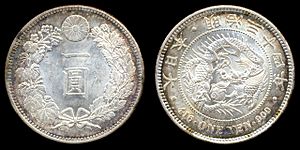
Coins were introduced in 1870, in silver 5, 10, 20 and 50 sen and 1 yen, and gold 2, 5, 10 and 20 yen. Gold 1 yen were introduced in 1871, followed by copper 1 rin, 1⁄2, 1 and 2 sen in 1873.
Cupronickel 5 sen coins were introduced in 1889. In 1897, the silver 1 yen coin was demonetized and the sizes of the gold coins were reduced by 50%, with 5, 10 and 20 yen coins issued. After 1920, all previous series of silver coins were discontinued in favor of cupro-nickel 10 sen and reduced-size silver 50 sen coins.
Production of silver 50 sen coins ceased in 1938, after which a variety of base metals were used to produce 1, 5 and 10 sen coins during the Second World War. Clay 5 and 10 sen coins were produced in 1945, but not issued for circulation.
After the war, brass 50 sen, 1 and 5 yen were introduced between 1946 and 1948. The current-type holed brass 5 yen was introduced in 1949, the bronze 10 yen in 1951, and the aluminum 1 yen in 1955.
Coins in denominations of less than 1 yen became invalid on December 31, 1953, following enforcement of the Small Currency Disposition and Fractional Rounding in Payments Act (小額通貨の整理及び支払金の端数計算に関する法律, Shōgaku tsūka no seiri oyobi shiharaikin no hasūkeisan ni kan suru hōritsu).
In 1955 the first unholed, nickel 50 yen was introduced. In 1957, silver 100 yen pieces were introduced, followed by the holed 50 yen coin in 1959. These were replaced in 1967 by the current cupro-nickel 100 yen along with a smaller 50 yen.
In 1982, the first cupronickel 500 yen coin was introduced. Alongside with the 5 Swiss franc coin, the 500 yen coin is one of the highest-valued coin to be used regularly in the world, with value of US$4.5 as of October 2017[update]. Because of its high face value, the 500 yen coin has been a favorite target for counterfeiters, resulting in the issuance in 2000 of the second nickel-brass 500 yen coin with added security features. Continued counterfeiting of the latter resulted in the issuance in 2021 of the third bi-metallic 500 yen coin with more improvements in security features.
The observe side of all coins shows the coin's value in kanji as well as the country name (through 1945, Dai Nippon (大日本, "Great Japan"); after 1945, Nippon-koku (日本国, "State of Japan") (except for the current 5-yen coin with the country name on the reverse). The reverse side of all coins shows the year of mintage, which is not shown in Gregorian calendar years, but instead in the regnal year of the current emperor's reign. For reference:
- Coins minted in 1900 bear the year 明治 (Meiji) 33, the 33rd year of Emperor Meiji's reign
- Coins minted in 1920 bear the year 大正 (Taisho) 9, the 9th year of Emperor Taisho's reign
- Coins minted in 1980 bear the year 昭和 (Showa) 55, the 55th year of Emperor Hirohito's reign
- Coins minted in 2000 bear the year 平成 (Heisei) 12, the 12th year of Emperor Akihito's reign
- Coins minted in 2020 bear the year 令和 (Reiwa) 2, the 2nd year of Emperor Naruhito's reign
| Currently circulating coins | |||||||||
|---|---|---|---|---|---|---|---|---|---|
| Image | Value | Technical parameters | Description | Date of first minting | |||||
| Diameter | Thickness | Mass | Composition | Edge | Obverse | Reverse | |||
 |
¥1 | 20 mm | 1.5 mm | 1 g | 100% aluminium | Smooth | Young tree, state title, value | Value, year of minting | 1955 |
 |
¥5 | 22 mm | 1.5 mm | 3.75 g | 60–70% copper 30–40% zinc |
Smooth | Ear of Rice, gear, water, value | State title, year of minting | 1959 |
 |
¥10 | 23.5 mm | 1.5 mm | 4.5 g | 95% copper 3–4% zinc 1–2% tin |
Reeded | Phoenix Hall, Byōdō-in, state title, value | Evergreen tree, value, year of minting | 1951 (rarely) |
| Smooth | 1959 | ||||||||
 |
¥50 | 21 mm | 1.7 mm | 4 g | Cupronickel 75% copper 25% nickel |
Reeded | Chrysanthemum, state title, value | Value, year of minting | 1967 |
 |
¥100 | 22.6 mm | 1.7 mm | 4.8 g | Cupronickel 75% copper 25% nickel |
Reeded | Cherry blossoms, state title, value | Value, year of minting | 1967 |
 |
¥500 | 26.5 mm | 1.85 mm | 7.2 g | Cupronickel 75% copper 25% nickel |
Lettered | Paulownia, state title, value | Bamboo, Mandarin orange, Value, year of minting | 1982 |
 |
¥500 | 26.5 mm | 2 mm | 7 g | (Nickel-brass) 72% copper 20% zinc 8% nickel |
Reeded slantingly | Paulownia, state title, value | Bamboo, Mandarin orange, Value, year of minting | 2000 |
 |
¥500 | 26.5 mm | 1.81 mm | 7.1 g | Bi-metallic (75% copper 12.5% zinc 12.5% nickel) |
Reeded helically | Paulownia, state title, value | Bamboo, Mandarin orange, Value, year of minting | 2021 |
| These images are to scale at 2.5 pixels per millimetre. For table standards, see the coin specification table. | |||||||||
Due to the great differences in style, size, weight and the pattern present on the edge of the coin they are easy for people with visual impairments to tell apart from one another.
| Unholed | Holed | |
|---|---|---|
| Smooth edge | ¥1 (light) ¥10 (medium) |
¥5 |
| Reeded edge | ¥100 (medium) ¥500 (heavy) |
¥50 |
Commemorative coins have been minted on various occasions in base metal, silver and gold. The first of these were silver ¥100 and ¥1,000 Summer Olympic coins issued for the 1964 games. The largest issuance by denomination and total face value were 10 million gold coins of ¥100,000 denomination for the 60th anniversary of reign of the Shōwa Emperor in 1986, totalling ¥1 trillion and utilizing 200,000 kg fine gold. ¥500 commemorative coins have been regularly issued since 1985. In 2008 commemorative ¥500 and ¥1,000 coins were issued featuring Japan's 47 prefectures. Even though all commemorative coins can be spent like ordinary (non-commemorative) coins, they do not normally circulate, and ¥100,000 coins are treated with caution due to the discovery of counterfeits.
The 1 yen coin is made out of 100% aluminum and can float on water if placed correctly.
Banknotes
The issuance of yen banknotes began in 1872, two years after the currency was introduced. Denominations have ranged from 1 yen to 10,000 yen; since 1984, the lowest-valued banknote is the 1,000 yen note. Before and during World War II, various bodies issued banknotes in yen, such as the Ministry of Finance and the Imperial Japanese National Bank. The Allied forces also issued some notes shortly after the war. Since then, the Bank of Japan has been the exclusive note issuing authority. The bank has issued five series after World War II.
Japan is generally considered a cash-based society, with 38% of payments in Japan made by cash in 2014. Possible explanations are that cash payments protect one's privacy, merchants do not have to wait for payment, and it does not carry any negative connotation like credit.
At present, portraits of people from the Meiji period and later are printed on Japanese bank notes. The reason for this is that from the viewpoint of preventing forgery, it is desirable to use a precise photograph as an original rather than a painting for a portrait.
Series E banknotes
Series E banknotes were introduced in 2004 in ¥1000, ¥5000, and ¥10,000 denominations. The EURion constellation pattern is present in the designs.
| Image | Value | Dimensions | Main Color | Description | Series | Date of issue | ||
|---|---|---|---|---|---|---|---|---|
| Obverse | Reverse | Obverse | Reverse | |||||
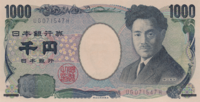 |
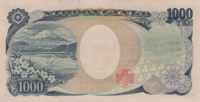 |
¥1000 | 150 × 76 mm | Blue | Hideyo Noguchi | Mount Fuji, Lake Motosu and cherry blossoms | Series E | November 1, 2004 |
 |
 |
¥2000 | 154 × 76 mm | Green | Shureimon | The Tale of Genji and portrait of Murasaki Shikibu | Series D | July 19, 2000 |
 |
 |
¥5000 | 156 × 76 mm | Purple | Ichiyō Higuchi | Kakitsubata-zu (Painting of irises, a work by Ogata Kōrin) | Series E | November 1, 2004 |
 |
 |
¥10,000 | 160 × 76 mm | Brown | Fukuzawa Yukichi | Statue of hōō (phoenix) from Byōdō-in Temple | Series E | November 1, 2004 |
Series F banknotes
On April 9, 2019, Finance Minister Tarō Asō announced new designs for Series F banknotes ¥1000, ¥5000, and ¥10,000 notes, for use beginning in 2024. The ¥1000 bill will feature Kitasato Shibasaburō and The Great Wave off Kanagawa, the ¥5000 bill will feature Tsuda Umeko and Wisteria flowers, and the ¥10,000 bill will feature Shibusawa Eiichi and Tokyo Station. The Ministry decided to not redesign the ¥2000 note due to low circulation.
| Series F (2024, scheduled) | |||||||
|---|---|---|---|---|---|---|---|
| Image | Value | Dimensions | Main
Color |
Description | Date of issue | ||
| Obverse | Reverse | Obverse | Reverse | ||||
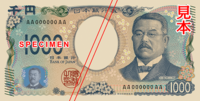 |
 |
¥1000 | 150 × 76 mm | Blue | Kitasato Shibasaburō | The Great Wave off Kanagawa (from Thirty-six Views of Mount Fuji series by Hokusai) | 2024, scheduled |
 |
 |
¥5000 | 156 × 76 mm | Purple | Umeko Tsuda | Wisteria flowers | |
 |
 |
¥10,000 | 160 × 76 mm | Brown | Shibusawa Eiichi | Tokyo Station (Marunouchi side) | |
Determinants of value
Beginning in December 1931, Japan gradually shifted from the gold standard system to the managed currency system.
The relative value of the yen is determined in foreign exchange markets by the economic forces of supply and demand. The supply of the yen in the market is governed by the desire of yen holders to exchange their yen for other currencies to purchase goods, services, or assets. The demand for the yen is governed by the desire of foreigners to buy goods and services in Japan and by their interest in investing in Japan (buying yen-denominated real and financial assets).
Since the 1990s, the Bank of Japan, the country's central bank, has kept interest rates low to spur economic growth. Short-term lending rates have responded to this monetary relaxation and fell from 3.7% to 1.3% between 1993 and 2008. Low interest rates combined with a ready liquidity for the yen prompted investors to borrow money in Japan and invest it in other countries (a practice known as carry trade). This has helped to keep the value of the yen low compared to other currencies.
International reserve currency
The special drawing rights (SDR) valuation is an IMF basket of the world's major reserve currencies, including the Japanese yen. Its share of 8.33% as of 2016 has declined from 18% as of 2000.
The percental composition of currencies of official foreign exchange reserves since 1995.

| US dollar | Euro | German mark | French franc |
| Pound sterling | Japanese yen | Other |
Historical exchange rate
Before the war commenced, the yen traded on an average of 3.6 yen to the dollar. After the war the yen went as low as 600 yen per USD in 1947, as a result of currency overprinting in order to fund the war, and afterwards to fund the reconstruction.
When MacArthur and the US forces entered Japan in 1945, they decreed an official conversion rate of 15 yen to the USD. Within 1945–1946: the rate tanked to 50 yen to the USD because of the ongoing inflation. During the first half of 1946, the rate fluctuated to 66 yen to the USD and eventually plummeting to 600 yen to the dollar by 1947 because of the failure of the economic remedies. Eventually, the peg was officially moved to 270 yen to the dollar in 1948 before being adjusted again from 1949 to 1971 to 360 yen to the dollar.
Beginning in 2022 the Yen rate has become increasingly weaker with each passing month. The reasoning behind this is the US moving towards higher interest rates, while Japan remains "ultra-low". Other factors include the strength of the US economy and its labor market, while Japan continues to lag behind its peers to bring its economy back to its pre-pandemic size. Japan’s trade balance staying in the red is also likely feeding into the weaker yen.
See also
 In Spanish: Yen para niños
In Spanish: Yen para niños
- Japan Mint
- Japanese military currency
- Economy of Japan
- Capital flows in Japan
- Monetary and fiscal policy of Japan
- Balance of payments accounts of Japan (1960–90)
- List of countries by leading trade partners
- List of the largest trading partners of Japan
- Korean Empire won (1902–1910)
Older currency
- Japanese mon (currency)
- Koban (coin)
- Ryō (Japanese coin)
- Wadōkaichin




